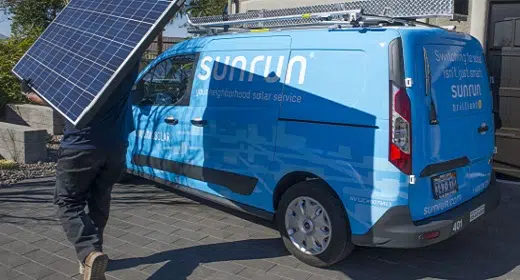As the head of the nation’s largest rooftop solar installer, Mary Powell has a stake in the recently passed Inflation Reduction Act, which includes tax credits to make rooftop solar more affordable…
But the CEO of Sunrun’s excitement about the bill’s passage goes beyond business. Powell was passionate about climate change long before it was a topic at cocktail parties. Now that President Joe Biden has signed the legislation into law, Powell believes the residential solar industry’s growth will accelerate, inching the nation closer to reaching its climate goals.
The Associated Press spoke with Powell about the impacts of the Inflation Reduction Act. Answers have been edited for length.
Q: How much will the Inflation Reduction Act boost the solar industry’s growth?
A: We are seeing 33% year-over-year growth and incredible customer demand. At the same time, we’re still collectively as an industry in only 4% of the 77 million addressable homes.
I think mainstream America is really becoming very aware of the value of solar plus storage plus electric vehicles. So this legislation, it just makes my heart sing, because it means so many more customers who would benefit from having a more affordable, resilient, comfortable future will now be able to do that.
We have to go from 4% of the addressable market to a much higher number to hit the kinds of emissions goals that are in this act.
Q: Does the legislation make it easier for lower-income Americans to access solar energy?
A: Our average customer right now has an average household income of $50,000 to $100,000. So with the additional support in the bill for lower-income, working class families, we really expect that to continue to be the segment that grows by orders of magnitude. So we’re really thrilled about that.
This has some really good incentives that will help us grow the multifamily housing work that we’re doing now.
So many decisions that affect energy-related emissions are made at the kitchen table. This bill is packed with ways that, when that kitchen table conversation happens, customers can see, “Oh, my gosh, I could go with an electric vehicle and save money, I could go with solar and save money. I could get storage and save money.” And then you bundle it all together, and the average American in that lower working class could really save $1,800 a year, which when you’re balancing school budgets, health care, food costs, etc., that’s a meaningful number for so many Americans.
Q: Why is increasing the amount of solar on rooftops so important to you?
A: Grandpa’s grid solution cannot be the sole solution of the future. It is a really important part of the solution.
Some people don’t realize the solar we put on roofs in a given year adds up to the amount of capacity of a nuclear power plant. Just think about that. And that’s on roofs all across America. So when we pair storage with it, another thing I get super excited about is then how can we leverage those assets working with the grid operators, with the utilities, to actually lower the cost of the grid for all and to make it more resilient for all.
Q: How have attitudes about climate change evolved since you started?
A: I used the word climate change and I basically was told, “Oof. Don’t ever use that word. You’ll be viewed negatively, people won’t take you seriously.”
I definitely was the skunk at the garden party at any of the utility events that I went to, talking about customer obsession, talking about innovation, talking about a distributed grid, talking about climate change. So things have changed dramatically.
It’s just so exciting to me that now there’s so much national and international interest. There’s so much money being invested in climate solutions, technology solutions. It’s a complete sea change over the last couple of decades. So even though I would have liked this to have moved faster — it’s the way I’m wired — I can also see that things have changed pretty dramatically and this bill can be the catalyst for that next really big change we need to make as a society.









































